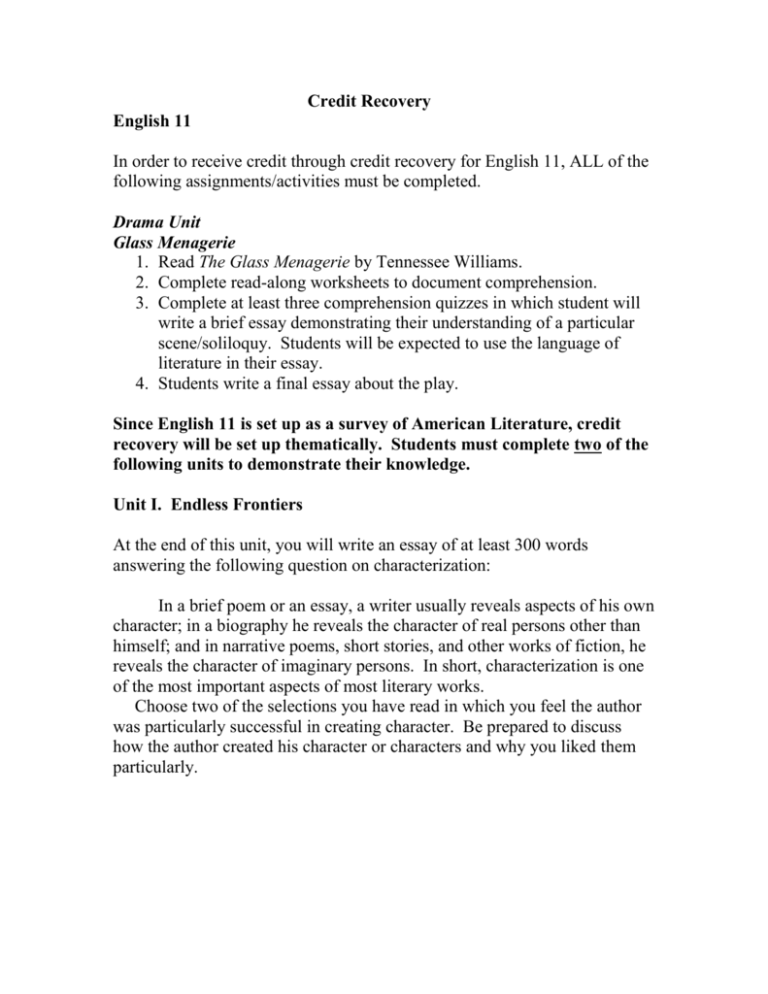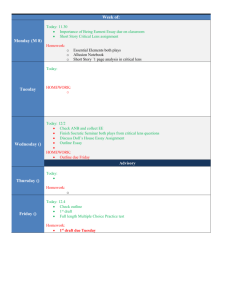Credit Recovery
advertisement

Credit Recovery English 11 In order to receive credit through credit recovery for English 11, ALL of the following assignments/activities must be completed. Drama Unit Glass Menagerie 1. Read The Glass Menagerie by Tennessee Williams. 2. Complete read-along worksheets to document comprehension. 3. Complete at least three comprehension quizzes in which student will write a brief essay demonstrating their understanding of a particular scene/soliloquy. Students will be expected to use the language of literature in their essay. 4. Students write a final essay about the play. Since English 11 is set up as a survey of American Literature, credit recovery will be set up thematically. Students must complete two of the following units to demonstrate their knowledge. Unit I. Endless Frontiers At the end of this unit, you will write an essay of at least 300 words answering the following question on characterization: In a brief poem or an essay, a writer usually reveals aspects of his own character; in a biography he reveals the character of real persons other than himself; and in narrative poems, short stories, and other works of fiction, he reveals the character of imaginary persons. In short, characterization is one of the most important aspects of most literary works. Choose two of the selections you have read in which you feel the author was particularly successful in creating character. Be prepared to discuss how the author created his character or characters and why you liked them particularly. Read four of the following and be prepared to discuss it with your HELP/AIS teacher. Choices: John Steinbeck - “The Leader of the People” - Read p. 14 on characterization - Discuss questions 1-5 “Implications” on pp. 12-13 Stephen Vincent Benet – “Western Star” - Discuss questions 1-5 – “Implications” on p. 20 - Discuss “Characterization” question on p. 20 William Cullen Bryant – “The Prairies” - Read “The Frontier Viewed Romantically” on p. 24 - Discuss question on setting in “Techniques” on p.24 George R. Stewart – “The Smart Ones Got Through” - Discuss setting and characterization questions in “Techniques” on p. 31 Jack London – “All Gold Canyon” - Read “Man vs. Nature, Man vs. Man” on p. 44 - Discuss the questions in “Implications” on p. 44 Conrad Richter – “Early Marriage” - Read “Reading between the Lines” on p. 54 - Discuss questions in “Implications” on pp. 54-55 - Discuss “Characterization” in “Technique” on p. 55 John Dos Passos – “The Campers at Kitty Hawk” - Discuss questions in “Implications” on p. 79 Willa Cather – “The Sculptor’s Funeral” - Discuss questions in “Implications” on p. 122 - Discuss “Setting” and “Characterization” on p. 122 in “Techniques.” Unit 2: The Inner Struggle Below are three critical lenses dealing with themes brought up in selections in this unit. Select ONE. Write a critical essay in which you discuss two works of literature from the unit, The Inner Struggle, that you have read from the particular perspective of the statement that is provided for you in the Critical Lens. In your essay, provide a valid interpretation of the statement, agree or disagree with the statement as you have interpreted it, and support your opinion using specific references to appropriate literary elements from the two works. Critical Lens #1: When an individual is faced with the need to make an important decision, the pressures exerted by the members of his family are generally not very important in determining his choice. Critical Lens #2: The need for a sense of integrity, of self-respect, is one of the most powerful impulses influencing human beings. Critical Lens #3: Fear freezes individuals and makes them incapable of arriving at intelligent decisions. Read four of the following and be prepared to discuss it with your HELP/AIS teacher. - Edgar Allan Poe – “William Wilson” John P. Marquand – “You Can’t Do That” Ambrose Bierce – “A Horseman in the Sky” John F. Kennedy – “ I looked down into my open grave . . . “ John Crowe Ranson – “Parting without a Sequel” Elinor Wylie – “Wild Peaches” Bernard Malamud – “A Summer’s Reading” Nathaniel Hawthorne – “Dr. Heidegger’s Experiment” Eugene O’Neill – “In the Zone” Unit 3: The Comic Imagination Unit final: Below are three critical lenses dealing with themes brought up in selections in this unit. Select ONE. Write a critical essay in which you discuss two works of literature from the unit, The Comic Imagination, that you have read from the particular perspective of the statement that is provided for you in the Critical Lens. In your essay, provide a valid interpretation of the statement, agree or disagree with the statement as you have interpreted it, and support your opinion using specific references to appropriate literary elements from the two works. Critical Lens #1: “Humor is meant to blow up evil and make fun of the follies of life.” Critical Lens #2: “Why we laugh is generally because we have seen or heard something that is at variance with custom.” Critical Lens #3: “. . . humor is the best that lies closest to the familiar, to that part of the familiar which is humiliating, distressing, even tragic.” Read four of the following and be prepared to discuss it with your HELP/AIS teacher. If you read the selections with the asterisks, you must read them all and they count as one selection. O. Henry – “Jeff Peters as a Personal Magnet” J. Frank Dobie – “Old Bill” *Ludwig Bemelmanns – “Little Bit and the America” *Ogden Nash – “The Politician” *e.e. cummings – “old age sticks” *Countee Cullen – “For a Mouthy Woman” Max Shulman – “Love Is a Fallacy” Dorothy Parker – “The Waltz” Ring Lardner – “Thompson’s Vacation” Robert Benchley – “Sporting Life in America: Dozing” Mark Twain – “The Celebrated Jumping Frog of Calaveras County” James Thurber – “The Night the Ghost Got In” Unit 4: The Struggle for Justice Stephen Vincent Benét – “Trials at Salem” Hamlin Garland – “Under the Lion’s Paw” Jesse Stuart – “Testimony of Trees” Edwin Markham – “The Man with the Hoe” Carl Sandburg – “The People Will Live On” Shirley Jackson – “The Lottery” Henry Wadsworth Longfellow - “The Arsenal at Springfield” Alan Seegar – “I Have a Rendezvous with Death” Phyllis McGinley – “Eleven O’Clock News Summary” Archibald MacLeish – “Lines for an Interment” Randall Jarrell – “Loses” Gwendolyn Brooks – “Looking” Walt Whitman – “When I Heard the Learn’d Astronomer” Stephen Crane – “The Bride Comes to Yellow Sky” Struggle for Justice Unit Final Techniques – Intention A reader can best grasp a writer’s intentions by focusing on the work itself and by paying close attention to such matters as word-choice, choice of incidents and details, and the amount of attention or development given to incidents and details. From time to time, a reader also knows whether or not a writer “means what he says.” Try to pick from the works in this unit at least one selection that employs a fair amount of exaggeration, one that uses objective statement, mainly, and one that makes extensive use of understatement. Discuss how you know which method the writer is using and why he may have chosen to use that method. The Novel Students will select one of the following: Ordinary People, The Great Gatsby, or Ethan Frome. Students will prepare reader-response journals as they read their novel. 1. Students will discuss the novel using their reader-response journals as a source for questions. 2. Students will create one short essay question for each chapter that would help another student determine theme or the importance of a particular chapter. 3. Students will find a critical lens quote that relates to the novel they are reading and write the essay. Final Exam Students will take an entire ELA Regents Exam, demonstrating proficiency with a grade of at least 70%.









